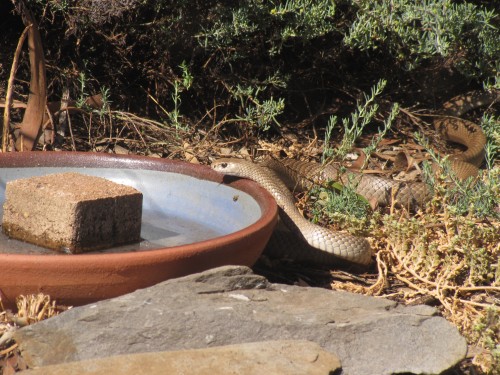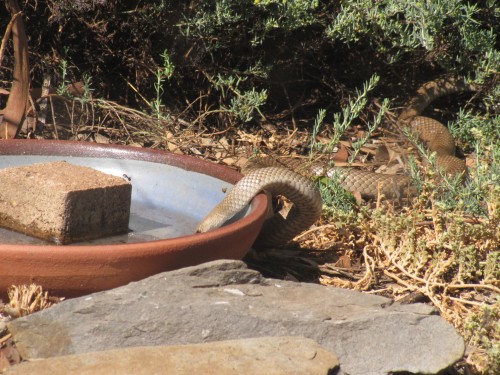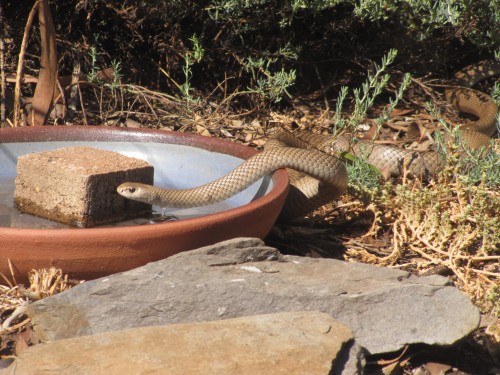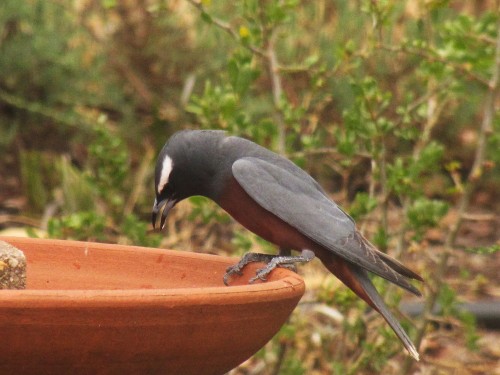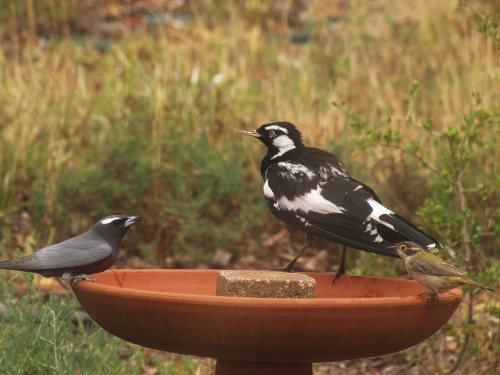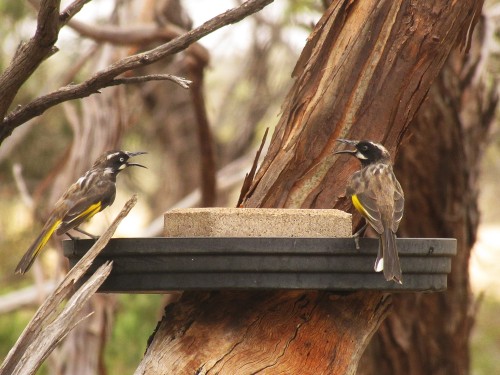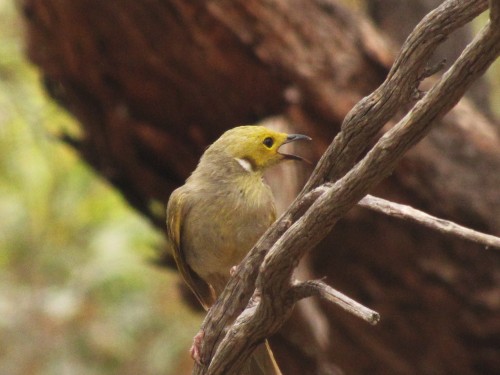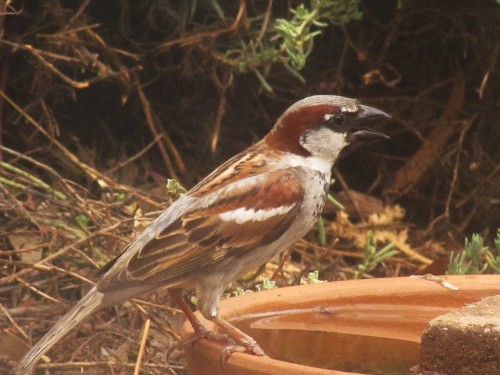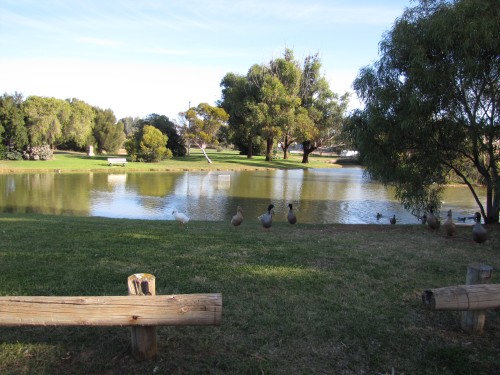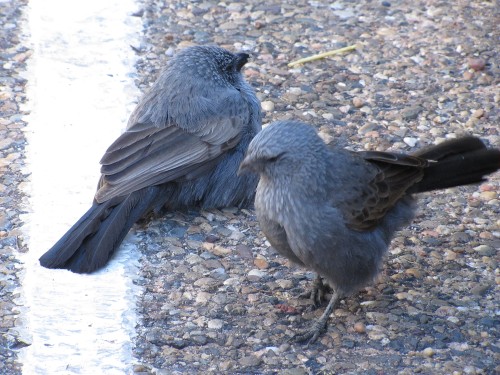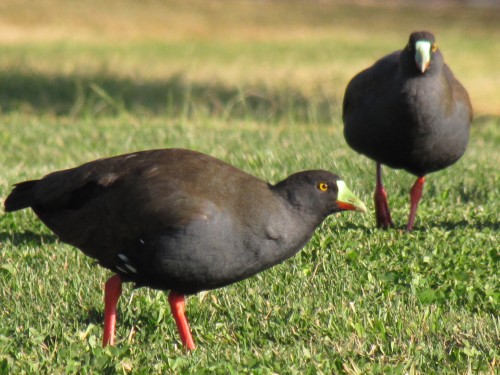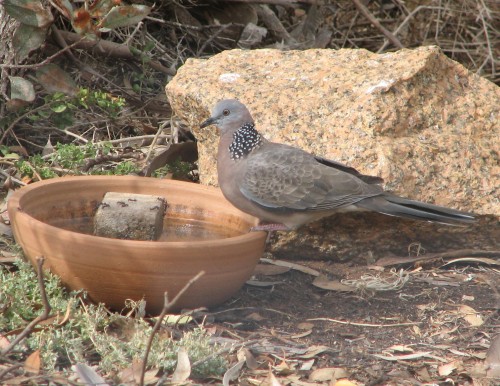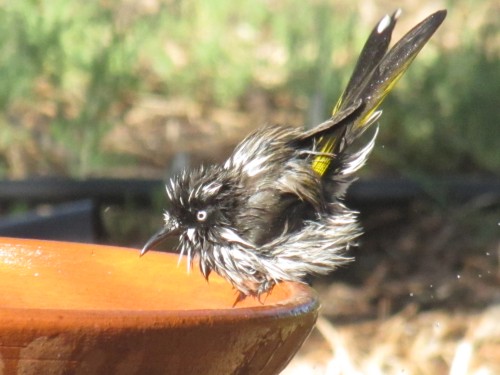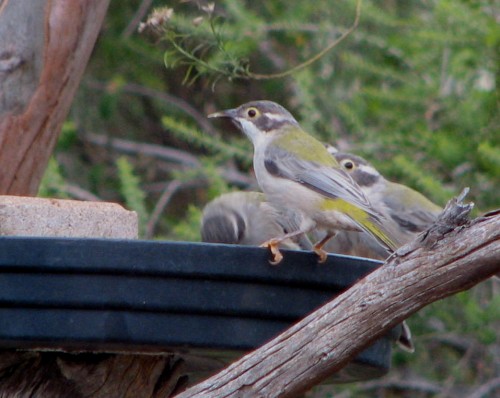Bird baths are not just for birds
Over the many years that we have had several bird baths in our garden we have seen many different kinds of birds visit for a drink or a bath – many times both. You can see a full list here.
Several of our bird baths are located in the garden close to our sun room, a place where we read the paper and often have our meals. The large picture window gives us a good view of that part of the garden and I often sit there with my camera at the ready. The room provides me with an excellent bird hide. Many of the photos I have shared on this site have been taken in this way.
Over the last few months I have often written about the extreme heat we have experienced here in South Australia over that period. Sure, we always expect some hot days in the 40 – 45 degree range (45C = 113F) but this summer – and the spring before it – has been exceptionally hot, breaking many records. Ironically, I am writing this on a quite cold day. It is currently only 20C and I have just decided that I might need some warmer clothing on.
On a hot day earlier this week we were sitting at the table when my wife spotted a metre long Eastern Brown Snake coming towards one of the bird baths. We were able to observe it for about five minutes. It actually stopped and had quite a long drink – perhaps for 20 – 30 seconds (see photos below). Although one individual approached quite close to the same bird bath some years ago, this is the first time I have observed one drinking.
Our five acre block of land on the outskirts of Murray Bridge has many of the typical habitat features preferred by this species. Although this is regarded as the world’s second most venomous snake, we are not overly concerned with their obvious presence near our home. If we leave them alone they just go about their lives in a non-threatening manner. Although several are probably resident on our property, we probably only see this species two or three times a year.
In reality we appreciate having them around. Our mouse and rat problem would be so much worse without them about. On only three occasions over 30 years of living here have we been concerned. The worst was when one found its way into the house; we were able to help it find an open door using a large piece of cardboard. The second was when a baby snake came towards me in our swimming pool. Babies can be just as dangerous as adults. The third occasion was one sunning itself in the entrance of my wife’s garden shed. All of these were unsettling events, but we avoided any harm.
Further reading:
White-browed Woodswallow at our bird bath
I must admit that I really enjoy seeing any of the six Australian species of woodswallows. On the downside, we only can expect to see three of those six species in our garden. To see the remaining three species I would have to travel several hundred kilometres to the north.
In fact, we only have fleeting visits from any of the woodswallows which occur in our area. They might hang around for a few minutes and then they are gone again. On most occasions I only see them swooping around high in the sky, presumably catching flying insects. On one special occasion two species flew in together and settled briefly – but long enough for photos.
Several weeks ago on one of the very hot days we are experiencing here in South Australia a solitary White-browed Woodswallow came to visit one of our bird baths – as recorded in the photos shown today. It was my wife who spotted it first and she was quite surprised; I don’t think that she had seen one up as close as this one. Because it was very thirsty it stayed around for quite a few minutes, long enough for me to take a good number of photos. At one stage it was not afraid to share the water with an Australian Magpie Lark (see below), a much larger species.
Further reading:
Birds in the heat
Here in South Australia we are experiencing our hottest summer on record. I won’t bore you with the details, but just say that we have had far too many days in the 40s (45C is equal to 113F). During such heatwaves – which can last for several days – our bird population suffers terribly. On these days the resident birds in our garden really appreciate the various bird baths we have placed in suitable locations.
Even on a warm day we get a constant parade of birds visiting the various bird baths in our garden. Our sun room overlooks several of them and this affords me an ideal location to take photos of them. Some birds still visit the water even on quite cold days – but we haven’t had many of those lately.
Probably the most common visitors would have to be the honeyeater species, including:
- Red Wattlebirds,
- White-plumed honeyeaters,
- New Holland Honeyeaters,
- Brown-headed Honeyeaters
- Singing Honeyeaters
- Spiny-cheeked Honeyeaters
Other regular visitors include:
- Australian Magpies
- White-winged Choughs
- Grey Currawong
- Australian Magpie Larks
- Crested Pigeons
- Spotted Turtledove
- Striated Pardalote
- Spotted Pardalote
- Silvereyes
- House Sparrow
- Common Starling
- Common Blackbird
A very short birding trip in Peterborough
Last week we spent several days visiting family in Peterborough in the mid-north of South Australia. The main focus of this trip was a belated Christmas family get together. My son’s family who were over from Sydney for a few weeks was the main focus, but it was also great to catch up with family members on my wife’s side of the family.
The weather was far too hot to do anything other than casual birding in the back yard. The only interesting sighting over the four days was a solitary Little Eagle soaring majestically overhead early one morning. The Peterborough area is an interesting region from a birding point of view. While many of the species seen further south are present, one can also see some of the more arid region birds around the town and in the nearby farming areas. This is about as far south as some of these arid dwelling birds venture.
One spot I always try to check out when visiting Peterborough is Victoria Park. This park, next to the town’s lovely swimming pool and caravan park features an artificial lake (see photo above). On and around this lake I have recorded quite a good range of water birds, one of the few spots in the region with enough water to sustain a small population of such species.
On this occasion we were actually on our way home. We left early to beat most of the heat of later in the day. I only drove though the park and didn’t actually stop. I guess that our visit was no longer than 2 minutes – if that. During that short time I saw the following species:
- Apostlebird
- White-winged Chough
- Australian Magpie
- Black-tailed Native-hen
- Pacific Black Duck
- Australian Wood Duck
- Mallard
- Australian Magpie Lark
- Crested Pigeon
- Galah
- Red Rumped Parrot
- Red Wattlebird
- Little Raven
It is not a long list but it does contain two interesting sightings.
Apostlebird
While Apostlebirds are quite common in the eastern parts of Australia, they are relatively rare in South Australia. They can only be seen in a handful of places. I have recorded them in the following locations:
- Taplan (SE of Loxton),
- Gladstone (mid-north of SA),
- Laura (just north of Gladstone)
- Stone Hut (just north of Laura)
- Appila (north of Gladstone)
- Peterborough (various locations around the town and district)
- Dawson Gorge (NE of Peterborough)
Several other locations have been reported by other birders in recent years. Peterborough is one of the more reliable spots for this species in South Australia. Over recent years I have seen the species in at least five spots around the town. You can read more about this species – go to the further reading section below.
Black-tailed Native-hen
On my recent visit to Victoria Park in Peterborough I saw about 5 Black-tailed Native-hens. I have seen this species on quite a few visits to this park. While the species is not rare it is unusual to see them in such a dry region as this. I suspect that these birds may actually be a resident breeding species. In some places, if the conditions are right, they can breed rapidly and within a short space of time number in the hundreds and even in the thousands. On previous visit to this park I have seen 20 – 50 birds.
Further reading:
- Apostlebirds in Peterborough
- Apostlebirds by the dozen
- Apostlebirds at Taplan in the Murray Mallee
- Apostlebirds in South Australia
The importance of water to birds
I love getting comments from my readers. Every now and then I get a really interesting one, like the one from Sue which I have quoted below.
Happy new year Trevor!
A Big thank you for maintaining your site…
I’m in suburban Adelaide, and I put a second bath into the garden when the hot weather struck early in the season. We have always had a terracotta pot pond with water lilies that allows for the bees to drink as well having a strong enough rim for some of the larger birds. The other two are just very large terracotta pot saucers, one on the ground, the other now in a raised garden bed under a deep shade tree.The ring neck dove (Spotted Turtle-dove) nested and fledged a chick in a hanging pot under the verandah.. Much cooler than her previous nest . Blackbird got it wrong and build a nest behind the fence post on the support rail .. But the iron faces west and is only shaded part of the day. She sat the nest for a full week before abandoning it, I suspect it was far too hot once the sun tracked round. Unfortunately, mid year, the neighbours had removed the large shrubs many of them had been using.
The New Holland honeyeaters, the Blackbird and the Wattlebirds have all now learnt to associate me out watering with a wet foliage cool off. The honeyeaters will actually make a fuss until I wet the bamboo down to make a cool and safe retreat then happily make use of it regardless of how close I am.
I suspect they may nest in the bamboo next year as its big enough to be a stable thicket.
All of them love it when the old fashioned rain wave sprinkler is put on.
They all seem to be learning new tricks to cope with the extra heat … with a little help from their friends.
Cheers
Sue.
Thank you, Sue, for sharing your delight in the birds in your garden.
If any of my readers would like to also share their experiences with birds in gardens – or other places for that matter, please leave a comment here on this article, or any article for that matter. You never know – I may feature your experiences in an article so everyone can read it.
Below I have included a few photos of birds at our bird baths.
Good birding,
Trevor.
Further reading:
- Time for a bath – an article about birds and other animals which have visited our bird baths.
